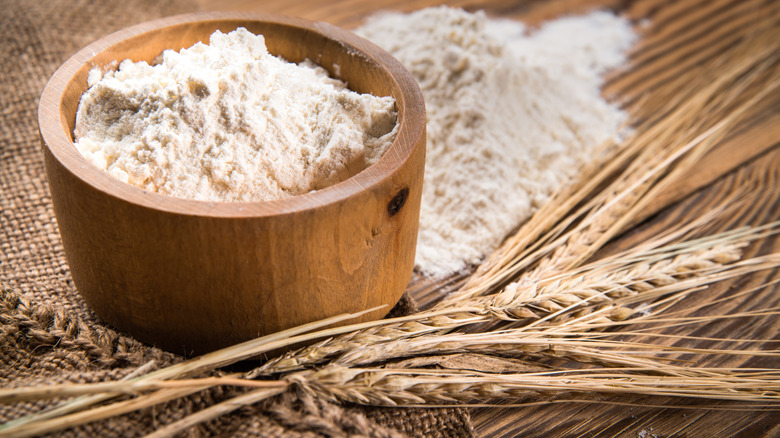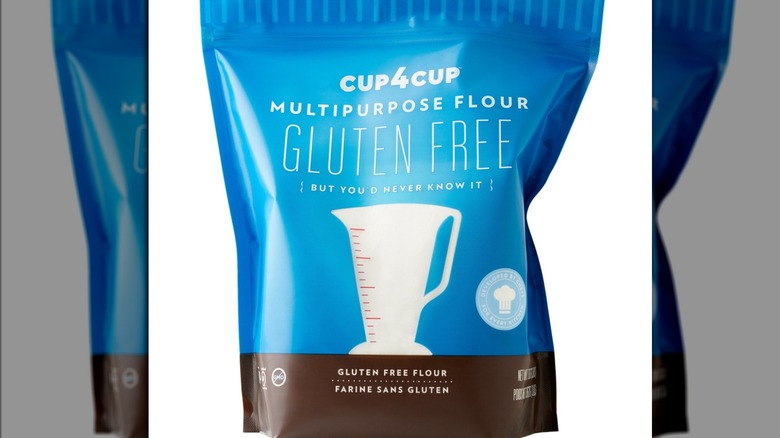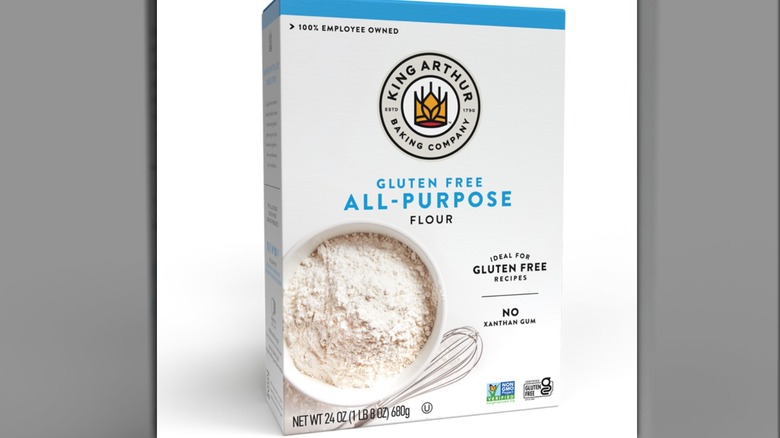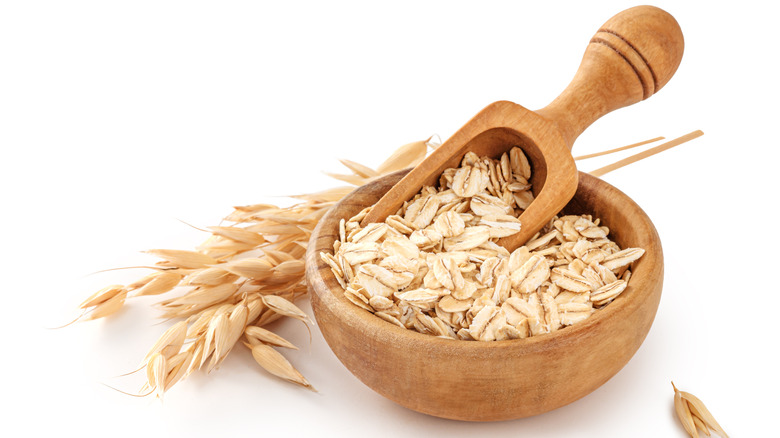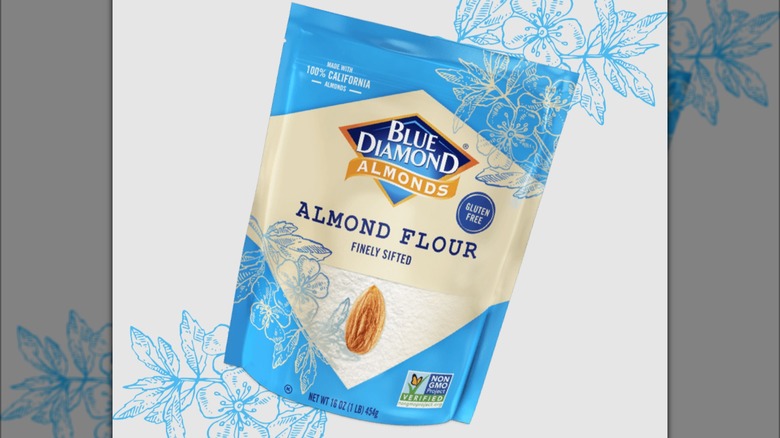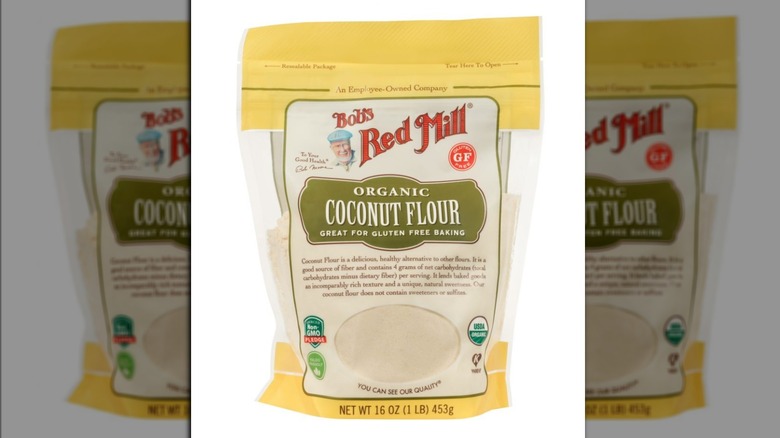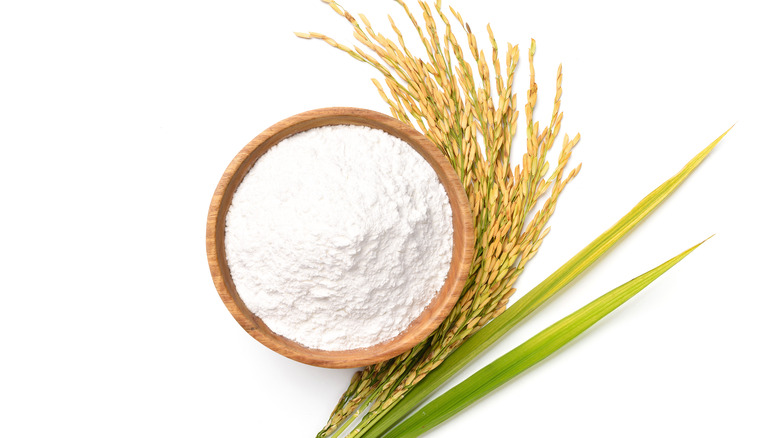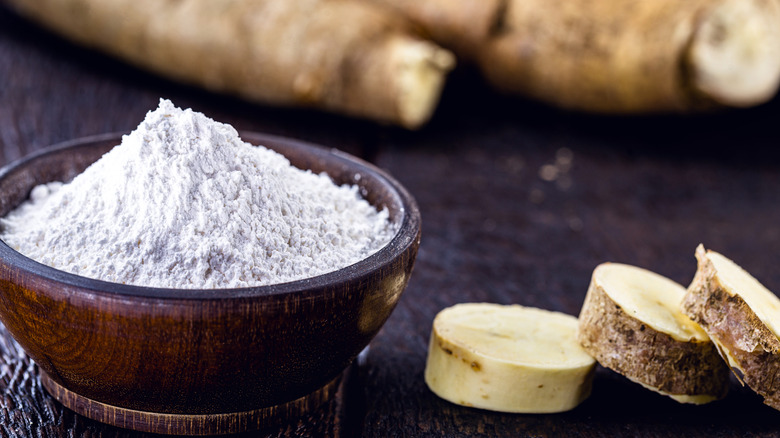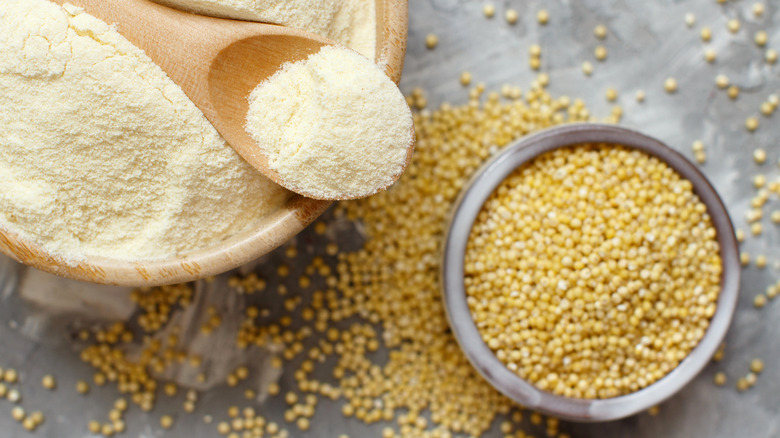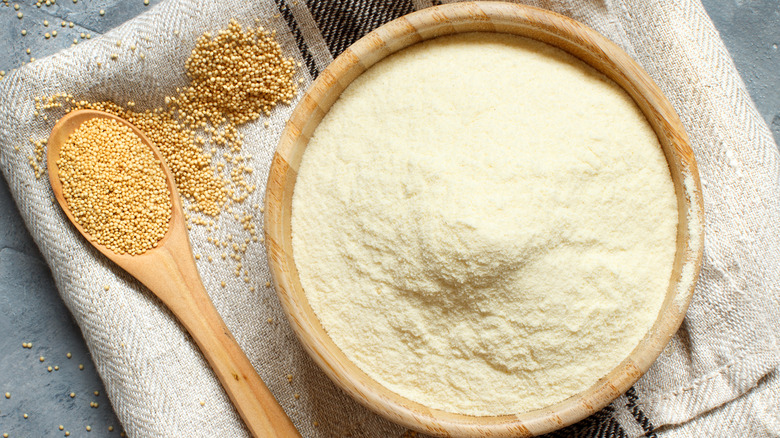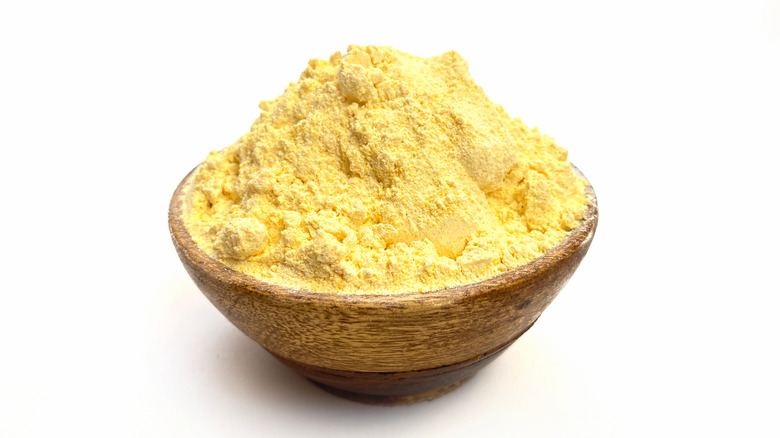10 Best Substitutes For Wheat Flour
Baking is a science, but there's room for substitution. That includes swapping out wheat flour in favor of other flours. To do so with finesse, it helps to look at flour not simply as a generic white powdery substance, but rather, as a composite of starch and protein (via Davidson Institute of Science Education).
In the case of wheat flour, the protein is gluten, or, more specifically, a network of glutenin and gliadin, which, when mixed with liquid, bind together to form gluten, according to Modernist Cuisine. Gluten acts like a "net" in bread dough made with wheat flour (or rye or barley flour, both of which also contain gluten, per Bob's Red Mill Blog). That net captures and organizes the little gas bubbles that form during leavening, lending the finished product lightness, chewiness, and some degree of elasticity. Determining the best substitute for wheat flour in any given baked goods recipe depends, as a starting matter, on what you desire in terms of consistency and structure in your finished product.
We'll be discussing that below with regard to each of the following best substitutes for wheat flour. We'll also be discussing other factors to be taken into consideration when swapping wheat flour out for another flour, including texture (wheat flour is a dense powder) and flavor (most wheat flour is neutral in flavor). Finally, we'll also be offering some suggestions on how best to deploy these substitutes for wheat flour in your own cooking.
1. All-Purpose Gluten Free Flour WITH Xanthan Gum
There are myriad reasons why you might want to use a substitute for wheat flour in a given recipe, but if you're looking to replace wheat flour to address Celiac disease or any other gluten intolerance, your choices will be slightly more circumscribed. First, gluten is found not only in wheat but also in barley and rye, per Bob's Red Mill. Accordingly, a gluten-free substitute for wheat flour must be free of these grains. At the same time, since gluten plays a structural and textural role in baking, whatever you're using as a substitute must somehow account for that. That is where gluten-free all-purpose flours containing xanthan gum come in.
Modeled on the moderately-glutenous composition, medium-soft texture, and neutral flavor, of basic white all-purpose wheat flour, a number of brands of gluten-free all-purpose flour are comprised of some combination of white neutral non-glutinous flours (including rice flour, tapioca flour, potato starch, and corn starch), plus a small amount of xanthan gum. Some of the more well-known brands include the Thomas Keller-affiliated "Cup4Cup" and Bob's Red Mill's "1-to-1,"
Xanthan gum is a flavorless dietary additive that acts as a thickening agent (per Amazing Food Made Easy). The small amount of xanthan gum in these cup-for-cup all-purpose gluten-free flour replacements helps gluten-free baked goods develop that chewy but airy consistency that comes naturally from 100% wheat flour. When using one of these all-purpose mixtures, the rule of thumb for substitution is one-for-one.
2. Gluten-Free Flour WITHOUT Xanthan Gum
Xanthan gum is a food additive that acts not only as a product stabilizer but also lends a much-needed chewiness and stretchiness to your gluten-free dough and your finished product, according to King Arthur Baking. Nevertheless, not all makers of gluten-free substitutes for all-purpose/multipurpose flour choose to include xanthan gum, and that includes the King Arthur Baking company.
"Our gluten-free flour doesn't contain xanthan gum, as we developed it to be ideal for a wide range of baked goods," the King Arthur company explains on its website. That means you can use King Arthur's all-purpose baking flour – or any other gluten-free flour whose ingredient list does not include xanthan gum – as a substitute for virtually anything in which you might otherwise use wheat flour. And that includes baking and cooking. For example, you can use it to dredge your fish sticks or fried chicken, and the absence of xanthan gum won't make any difference. In fact, your finished product might be somewhat lighter and crispier, if that's what you're looking for.
However, when you're using it in baking, you'll want to add your own xanthan gum, which you can find in supermarkets everywhere. King Arthur suggests starting out by using a quarter teaspoon of xanthan gum for every 1 cup of flour that a recipe may call for. For flakier, softer baked goods, you can experiment with using less. For chewy baked goods such as bread or pizza, try using a bit more.
3. Oat Flour
Oat flour is another popular substitute for wheat flour. Slightly sweet and nutty, oat flour is not quite as neutral in flavor as white wheat flour, but this can work to your advantage in baking, per Okonomi Kitchen. In addition, oat flour is softer in texture than wheat flour, which can enhance the tenderness of cakes and quick breads (i.e., cake-like breads that don't rely on yeast and its fermentation for leavening). In fact, Food & Wine considers oat flour's texture, as well as its absorbency, to be "essential" in gluten-free white and yellow cake recipes.
At the same time, oat flour is relatively high in protein and fiber, so it can add thickness and chewiness to cookies, and it works particularly well as a substitute for wheat flour in recipes containing eggs, which help to add structure and elasticity to baked goods, per Cookie and Kate. For eggless recipes, you can add xanthan gum - a quarter teaspoon for every cup of flour, per King Arthur Baking. Further, you can combine oat flour with almond flour, which adds moistness and heft, per Okonomi Kitchen.
All of that said, despite that oat flour's protein content is similar to that of bread flour (per VegFAQs), oat flour is actually not recommended as a substitute for wheat flour on a one-to-one basis in yeast breads, according to Bon Appétit. For these, you'll have better results if you swap out only about one quarter of the wheat flour called for.
4. Almond Flour
Almond flour, which is made from ground, blanched almonds, can be substituted on a one-to-one basis for wheat flour, according to various sources, including The Neff Kitchen and Blue Diamond. Nevertheless, doing so will require a few adjustments to account for some of the essential differences between almond flour and wheat flour. For one thing, almond flour is moister than wheat flour – owing to its higher fat content, according to Neff Kitchen, which means doughs and batters made with it may be wetter than those made with wheat flour. Depending on your recipe, that may require the addition of some additional almond flour (which you should do only very gradually to make sure you don't overdo it).
Almond flour is also higher in protein than wheat flour, per VegFAQ, but because its texture is more coarse, and because the protein in almond flour is not and does not form gluten, almond flour could use a bit of help in binding together. For that purpose, both Neff and Blue Diamond recommend adding some egg (or egg white) to recipes in which you're substituting almond flour for wheat (because eggs help impart structure, per Sara Moulton).
In addition, you can add xanthan gum (a quarter teaspoon per cup of flour called for), per Panhandle Milling. However, if you're looking to substitute almond flour for wheat flour in yeast-risen bread recipes, King Arthur Baking recommends doing so only with respect to a third of the wheat flour called for.
5. Coconut Flour
Coconut flour, which is made from coconut meat, is rich in dietary fiber and low in carbohydrates, making it a more nutrition-packed alternative to wheat flour. However, it does have a mildly coconut-y taste, according to A Saucy Kitchen. In addition, it doesn't necessarily work as a substitute for all of the wheat flour in any given recipe, according to various sources, including Bob's Red Mill.
Bob's Red Mill points out that one stumbling block to a measure-for-measure swap, in this case, is that coconut flour's high fiber content (relative to wheat flour) means that it absorbs more liquid than wheat flour during the baking process. To counteract this, as well as to add structure to your finished product, you can add more eggs than a recipe calls for. In recipes for baked goods that don't include eggs, you'll want to add xanthan gum to help your finished product hold together better, according to Bob's Red Mill Blog. However, even more importantly, it's best to limit the amount of coconut flour you're swapping to ¼ to ⅓ cup for each cup of wheat flour a recipe calls for.
Another use for coconut flour as a wheat flour substitute, is as a thickener for soups, according to Saucy Kitchen, and this can be done one-for-one. The only caveat is that it works best in soups with flavors that can stand up to the coconut flavor in coconut flour.
6. Rice Flour
Rice flour is a popular ingredient in many pre-packaged gluten-free flour mixtures. However, it doesn't work quite so well on its own in baking because rice is harder and less absorbent than wheat and may, therefore, result in a gritty, gummy product. One way to counteract this, according to Kitchn, is to mix it with tapioca starch. The proportion recommended by Kitchn is a half cup of tapioca flour for every pound of rice flour. In most cases, you'll also want to add xanthan gum (one quarter teaspoon per cup of flour called for in the recipe) to lend the structure to your finished product that wheat flour would otherwise provide, according to Know Your Pantry.
Rice flour is the primary ingredient in a number of different types of noodles, particularly in various parts of Asia, per Thrillist, but if you're looking to substitute rice flour in a straight-up "pasta" recipe (i.e., one that calls for wheat flour of one kind or another), you'll want to use the rice flour slash tapioca flour combination referenced above, plus xanthan gum and eggs, according to Gluten-Free Baking.
Although rice flour isn't recommended for baking yeast-risen breads, it can work well in biscuits and quick breads. It can also be substituted for wheat flour on a one-to-one basis in gravies, stews, and soups, without adding any detectable flavor (per Savory Nature).
7. Cassava Flour
Cassava flour is flour made from the root of the cassava plant, according to Medical News Today. So too is tapioca starch, except that tapioca starch is primarily starch and has a negligible protein content per Healthline. That makes tapioca starch less useful as a wheat flour substitute, except when used in combination with other flours with a higher protein content — such as rice and almond (via Bob's Red Mill). By contrast, cassava flour can work as a one-to-one substitute for wheat flour in baking recipes, according to 40 Aprons, albeit not in every recipe.
First, cassava flour may add a nutty flavor to your baked goods (per Medical News Today), which isn't necessarily a bad thing, but it is certainly something to consider. Further, cassava flour's taste may not work well in dishes that are meant to be savory, as opposed to sweet, according to Substitute Cooking. In addition, although cassava flour has a consistency similar to wheat flour, it does tend to soak up more of a recipe's liquids than wheat flour, Food52. This may make your batter or dough seem more dry than if you were making it with wheat flour. If you end up using less flour than the recipe calls for, this will generally work out just fine if you're making cookies, brownies, or thin cake layers. However, in thicker baked goods such as loaf cakes, it may result in a wet interior. Just something to keep in mind.
8. Millet Flour
Millet flour is made from the millet seed, according to Bob's Red Mill, which touts millet flour as being "wonderfully nutritious and a good source of protein, essential amino acids, and dietary fiber" as well as the minerals, manganese, phosphorus, and magnesium. Millet flour doesn't have quite as neutral a flavor as wheat flour, according to Our Everyday Life, which describes millet flour's flavor as somewhat buttery. However, that may work to your advantage, depending on the recipe in which you're using millet flour as a wheat flour substitute. Millet flour also has a light yellow color that you'll want to take into account before adding it to your baked goods.
According to Substitute Cooking, you can substitute millet flour for wheat flour on a cup-for-cup basis. However, Bob's Red Mill suggests replacing no more than a quarter of the wheat flour your recipe calls for with millet flour. Doing so helps deliver a "delicate cake-like crumb" to your baked goods. Because millet flour contains no gluten, it works best when combined with a helper ingredient such as xanthan gum or psyllium husks, both of which help infuse your baked good with some of the chewy structure that the gluten in wheat flour would normally offer, per PowerHungry.
9. Amaranth Flour
Amaranth flour is another gluten-free and protein-rich flour that can be used as a substitute for wheat flour, according to SF Gate. Like millet flour, amaranth flour is made from grinding the seeds of a plant (i.e., the amaranth plant) and has a light yellow hue. According to Substitute Cooking, amaranth flour, which is prized for being high in fiber and calcium as well as other vitamins and minerals, has the rather unusual distinction among stand-alone wheat flour substitutes of being able to stand in for wheat flour in yeast-based breads, as well as in quick breads, cakes, and other baked goods.
What you will want to be aware of when substituting amaranth flour for wheat flour is that while its flavor has been described as nutty, it has also been described as "grassy," which may not work as well in sweet dishes as it does in savory dishes such as pizza dough, according to Culinary Nutrition. Although Culinary Nutrition recommends swapping amaranth flour for wheat flour on a one-to-one basis, some others, including Bob's Red Mill, advise swapping out no more than a quarter of what your recipe calls for in terms of wheat flour with amaranth flour. The other thing to be aware of if you decide to pick up some amaranth flour to use in place of wheat flour is that it can spoil and become rancid if not stored in the refrigerator, and preferably, in a "sealed glass jar," according to Substitute Cooking.
10. Chickpea Flour
No list of the best substitutes for wheat flour would be complete without a mention of chickpea flour. According to Bob's Red Mill, chickpea flour is made from raw chickpeas, aka garbanzo beans, which are some of the "creamiest and tastiest of beans" out there. Because chickpeas are so closely associated with those savory fried veggie fritters that are known as "falafel," you might think of chickpea flour as being best used in savory baked goods such as bread, pizza crust, flatbreads, and crackers. However, chickpea flour actually lends a "sweet, rich flavor" to all manner of baked goods, including the sweetest of cakes, muffins, and quick breads – and even those made with such assertive flavors as chocolate and pumpkin.
Like many of the other best wheat flour substitutes discussed herein, chickpea flour is an easy one-for-one swap for wheat flour in soups, stews, and sauces. However, in baking, Bob's Red Mill recommends replacing no more than a quarter of the wheat flour called for in the recipe with chickpea flour. On the other hand, others, including My Recipes and Lacademie suggest that it's perfectly acceptable to swap chickpea flour for wheat flour on a one-to-one basis, even in baked goods.
